Keywords
|
| Direct Torque Control(DTC),Brushless dc (BLDC) motor drive, Rotor Position Estimation, LabVIEW |
INTRODUCTION
|
| PERMANENT MAGNET BRUSHLESS DC MOTOR with trapezoidal shape back emf drive is used in many applications, since it has a lot of advantage of smaller size, high power density, high efficiency, large torque to inertia ratio, and less maintenance. Unlike brushed DC motors, every brushless motor requires a “drive” to supply commutated current to the motor windings synchronized to the rotor position. The BLDC motors are generally fed from a quasi rectangular current and have trapezoidal back EMF in order to reduce the torque ripple and thus maximize the efficiency and torque capability. |
| The most popular way to control BLDC motor is by PWM current control. But this current controller assumes that the torque is proportional to the phase current. However in practice, the relationship is non-linear. This will cause more ripple in the torque. In this paper, the application of DTC to a BLDC drives operating in the two phase conduction mode to achieve instantaneous torque control and reduced torque ripple. However, in its implementation to a BLDC drive, the estimated torque was obtained from a look-up table and the control algorithm did not directly involve the flux control. |
| In common, three hall effect sensors are usually used as position sensors to detect the current commutation points that occur at every 60 electrical degrees. Due to non ideal trapezoidal shape back emf, the output of hall sensors is not accurate. So in this paper rotor position is estimated from the instantaneous values of voltage and currents. Further, two phase conduction method is to be used rather than a three phase one which may create problem in high speed applications. |
| The paper is organized as follows. In sect. II, the proposed DTC of BLDC motor drive in two-phase conduction mode is explained in detail. The simulation results and analysis of the proposed DTC of BLDC motor drive in twophase conduction mode in the constant torque region with rotor position estimation in LabVIEW environment are given in sect. V. |
DTC OF BLDC MOTOR DRIVE
|
| Direct Torque Control (DTC) was proposed for the first time by Takahashi and Noguchi in 1986 and Depenbrock in 1988 for Induction motors. Recently many researches worked on DTC of BLDC motor for specific applications which needs precise torque control. The basic concept behind the DTC of ac drive, as its name implies, is to control the electromagnetic torque and flux linkage directly and independently by the use of six voltage space vectors found in lookup table. |
| The electromagnetic torque estimation is the key factor in the DTC of a BLDC motor drive in the constant torque region. For a surface–mounted BLDC motor the back-EMF waveform is trapezoidal irrelevant of conducting mode. Therefore the electromagnetic torque equation in stationary reference frame is given by |
 |
 |
| BLDC operates in both constant torque region and constant power region. Back-EMF of motor is below the DC voltage source of inverter in constant torque region (below base speed) and is increased more than DC voltage value above nominal speed. Therefore stator inductance avoids abrupt increase of phase current and deteriorates output torque of motor. Therefore in this paper operation of BLDC motor is considered only in the constant torque region. |
| Torque error, stator flux error, and stator flux angles are regularly used to select proper voltage space vector for switching in DTC technique. In this paper flux linkage error is eliminated because of variations of stator flux magnitude regarding changes in resistance, current and voltage, and specifically sharp dips at every commutation. This is due to the presence of freewheeling diode. Therefore the control of stator flux linkage is very complex. |
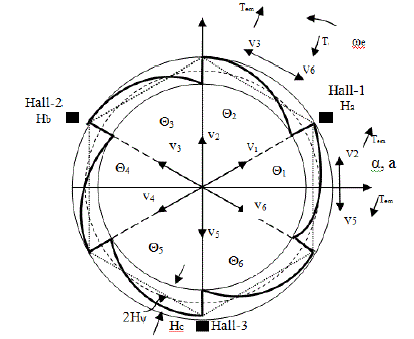 |
| Fig. 1. Actual and ideal (straight dashed lines) stator flux linkage trajectories representation of two-phase voltage space vectors, and placement of the three hall-effect sensors in the stationary αβ−axes reference frame, |
| It has also been observed from the stator flux linkage trajectory that when conventional two-phase PWM current control is used, sharp dips occur every 60 electrical degrees. Due to the sharp dips in the stator flux linkage space vector at every commutation and the tendency of the currents to match with the flat top part of the phase back- EMF for smooth torque generation, there is no easy way to control the stator flux linkage amplitude. The best way to control the stator flux linkage amplitude is to know the exact shape of it, but it is considered too cumbersome in the constant torque region. Therefore In the proposed DTC of a BLDC motor with two-phase conduction scheme, the flux error (φ) in the voltage vector selection look-up table is always selected as zero and only the torque error (τ) is used depending on the error level of the actual torque from the reference torque. If the reference torque is bigger than the actual torque, within the hysteresis bandwidth, the torque error (τ) is defined as “1”, otherwise it is “-1”, as shown in Table I. |
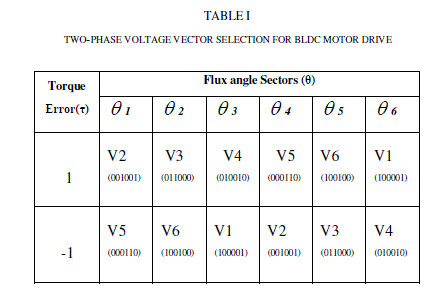 |
| The possible eight voltage space vectors used in DTC are shown in Fig. 1.In each region two adjacent voltage vectors, which give the minimum switching frequency, are selected to increase or decrease the amplitude of stator flux linkage, respectively. For example, according to the Table I, when the voltage vector V2 is applied in Sector 1, then the amplitude of the stator flux increases when the flux vector rotates counter-clockwise. If V3 is selected then stator flux linkage amplitude decreases. Thus by proper selection of voltage space vector electromagnetic torque of the BLDC motor drive can be controlled directly. |
A. Proper Stator Voltage Space Vector Selection for the Control of Electromagnetic torque
|
| A change in the torque can be achieved by keeping the amplitude of the stator flux linkage constant and increasing the rotational speed of the stator flux linkage as fast as possible. Thus fast torque response is achieved. In this paper, the rotational speed of the stator flux linkage can be controlled by selecting the proper voltage vectors while keeping the flux amplitude almost constant. That means flux control is eliminated here. |
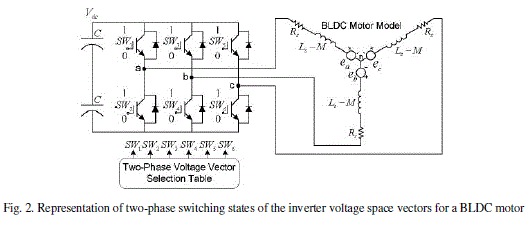 |
 |
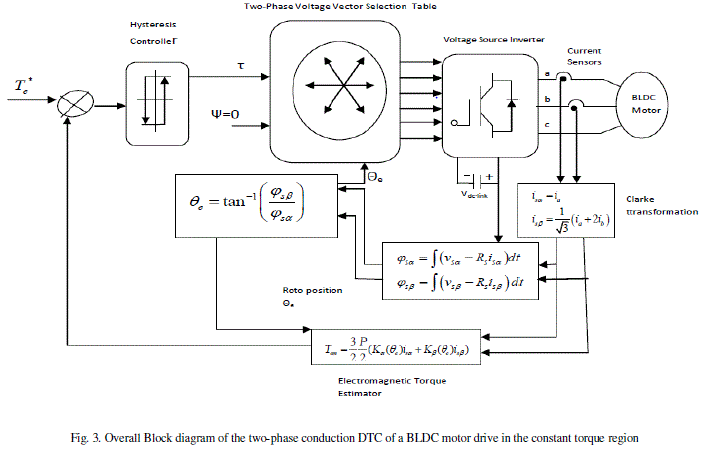 |
| If a BLDC motor has an ideal trapezoidal back-emf having a 120 electrical degree flat top, one current sensor on the dc-link can be used to estimate the torque. Usually the overall control system of a BLDC motor drive includes three hall-effect position sensors mounted on the stator 120 electrical degrees apart. These are used to provide low ripple torque control if the back-emf is ideally trapezoidal because current commutation occurs only every 60 electrical degrees. In reality, back-emf of BLDC motors is not ideally trapezoidal. Hence the rotor position is estimated from the back emf constants as opposed to the hall sensor output. |
 |
B. Estimation of Rotor Position
|
| Electrical rotor position θ which is required in the torque estimation algorithm and which provides a position sensorless DTC scheme can be found by |
 (2) (2) |
Where  are the stationary reference frame flux linkages and it can be expressed as follows, are the stationary reference frame flux linkages and it can be expressed as follows, |
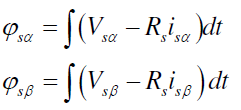 (4) (4) |
Where  are the stationary reference frame voltages and current. are the stationary reference frame voltages and current. |
SIMULATION RESULTS
|
| The drive system shown in Fig. 3 has been simulated in LabVIEW. |
| A. LabVIEW In Virtual Instrumentation |
| Virtual instrumentation software is based on user requirements. It defines general purpose measurement and control hardware functionality. Virtual instrumentation combines main stream commercial technologies, such as pc, with flexible software and a wide variety of measurement and control hardware, So engineers and scientists can create userdefined systems that needs their exact application needs with virtual instrumentation, Engineers and scientists can reduce development time, design higher quality products, lower their design costs. Only with virtual instrumentation can engineers and scientists create the user-defined instruments required to keep up with the world’s demands. Another virtual instrumentation component is modular I/O, designed to be rapidly combined in any order or quantity to ensure that virtual instrumentation can both monitor and control any development aspect. LABVIEW (Laboratory Virtual Instrumentation Engineering Workbench) is a graphical programming language that uses icons instead of lines of text to create applications. LABVIEW program facilitates Virtual Instrumentation (VI), which imitates the appearance and operation of physical instruments. VI is defined as a process of combining hardware and software with industry standard computer technology to create a user-defined instrumentation solution. Several other add-on toolsets can be incorporated for developing the specialized applications. |
| To set the gating signals of the power switches easily and represent the real conditions in simulation as close as possible the electrical model of the actual BLDC motor with R-L elements are designed in LabVIEW. The non ideal effects of the BLDC machine are neglected in the simulation model. The switching table, which is given in Table I is employed for the proposed DTC of the BLDC motor drive. The magnitude of the torque hysteresis bands is 0.001. It may be noted that the zero voltage vector is not used in the proposed scheme. |
| Table II shows the ratings and parameters of the BLDC motor considered. |
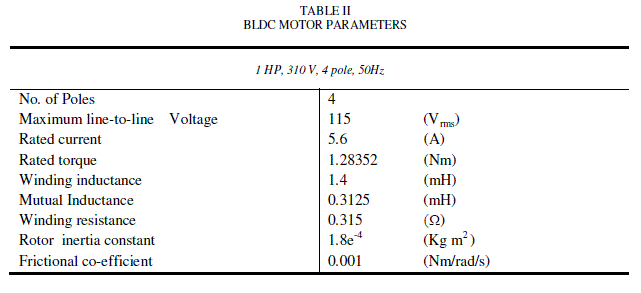 |
| Figs. 4-9 show phase currents, motor speed, actual electromagnetic torque, estimated electromagnetic torque, back emfs and phase voltages respectively under only torque control. The proposed scheme is demonstrated under 1.2 Nm load torque and it is applied at 0.4sec. When the load is suddenly increased the q-axis current amplitude also increases and fast torque response is achieved. The estimated torque follows the desired torque satisfactorily. When the load torque changes abruptly, there is a dip in the speed response The ripple seen in the torque and current can be minimized by properly selecting the torque hysteresis band size. |
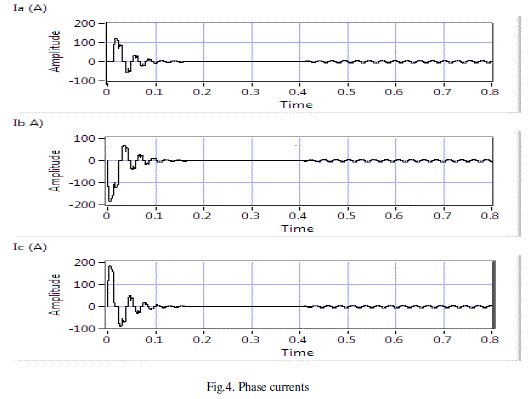 |
| Fig.4 shows the phase currents. The current start with a high value and decays as the motor speeds up until it reaches the no-load current. The current rises again when the load torque is applied and reaches a steady state value. |
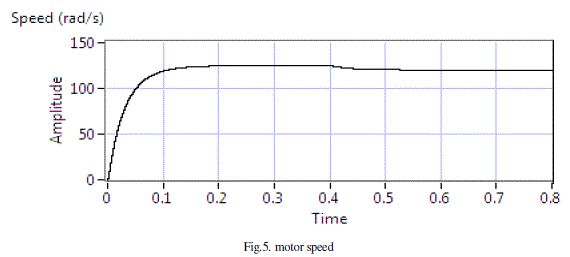 |
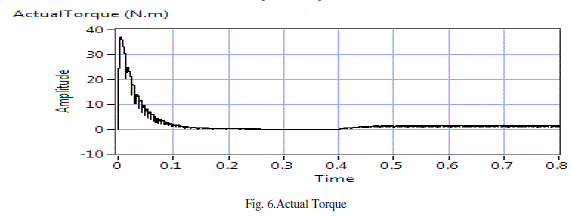 |
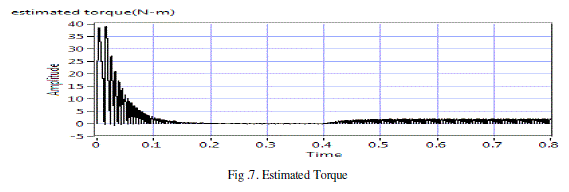 |
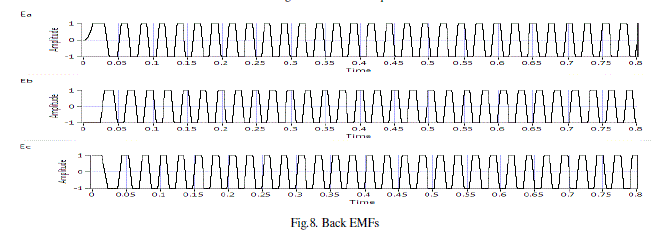 |
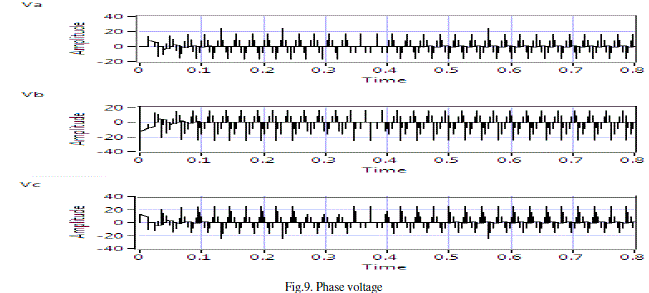 |
 |
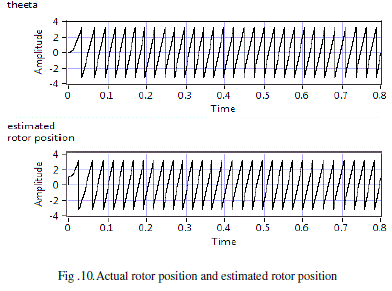 |
CONCLUSION
|
| The DTC for BLDC motor drive using two phase conduction mode in the constant torque region with rotor position estimation has been successfully implemented in LabVIEW . A look-up table for the two-phase voltage vector selection is designed to provide faster torque response both on rising and falling conditions. Compared to the three phase DTC technique, this approach eliminates the flux control and only torque is considered in the overall control system. Three reasons are given for eliminating the flux control. First, since the line-to-line back-EMF including the small voltage drops is less than the dc-link voltage in the constant torque region there is no need to control the flux amplitude. Second, with the two-phase conduction mode sudden sharp dips in the stator flux linkage locus occur that complicate the control scheme. The size of these sharp dips is unpredictable. Third, regardless of the stator flux linkage amplitude, the phase currents tend to match with the flat top portion of the corresponding trapezoidal back-EMF to generate constant torque. To eliminate the low-frequency torque oscillations a prestored back-emf versus electrical rotor position look-up table is designed and used in the torque estimation. Electrical rotor position required in the torque estimation is obtained using winding inductance, stationary reference frame currents and stator flux linkages. |
| |
References
|
- SalihBarisOzturk, Oh Yang, Hamid A. Toliyat “Power Factor Correction of Direct Torque Controlled Brushless DC Motor Drive” @2007 IEEE
- S. B. Ozturk and H. A. Toliyat, “Direct torque control of brushless dc motor with non-sinusoidal back-EMF,” in Proc. IEEE-IEMDC Annu. Meeting, Antalya, Turkey, May 3-5, 2007.304.
- Y. Liu, Z. Q. Zhu, and D. Howe, ‘‘Direct torque control of brushless dc drives with reduced torque ripple,’’ IEEE Trans. Ind. Appl., vol. 41, no.2, pp. 599--608, Mar./Apr. 2005.
- S. J. Kang and S. K. Sul, “Direct torque control of brushless dc motor with nonideal trapezoidal back-EMF,” IEEE Trans. Power Electron., vol. 10, no. 6, pp. 796–802, Nov. 1995.
- L. Hao, H. A. Toliyat, “BLDC motor full-speed operation using hybrid sliding mode observer,” in Proc. IEEE-zPECAnnu. Meeting, Mia FL, Feb. 9-13, 2003, vol. 1, pp. 286-293.
- S. B. Ozturk and H. A. Toliyat, “ Direct torque and indirect flux control of brushless dc motor ,” IEEE Tran. Mechatronics, vol.16, No.2,, pp. 351–360, Apr. 9–11, 2011.
- T.J.E Miller, “Brushless Permanent Magnet and Reluctance Motor Drives,” Oxford, 1989.
|